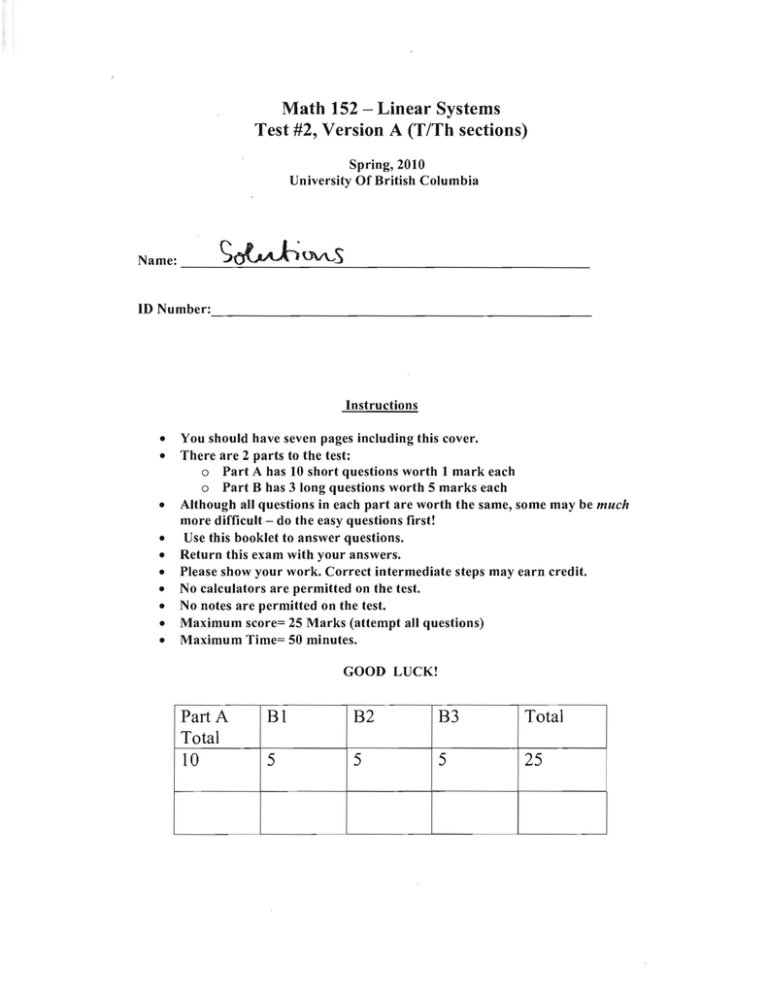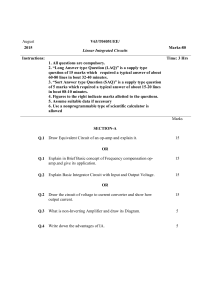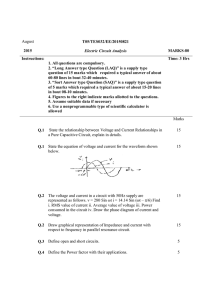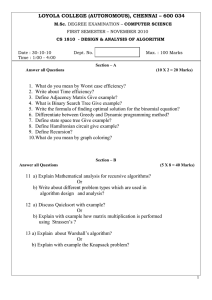Document 11103741
advertisement

Math 152 - Linear Systems Test #2, Version A (T/Th sections) Spring, 2010
University Of British Columbia
Name:<;otvuh~s
------~--------------------------------------------
ID Number:______________________________________
Instructions
• You should have seven pages including this cover.
• There are 2 parts to the test:
o Part A has 10 short questions worth 1 mark each
o Part B has 3 long questions worth 5 marks each
• Although all questions in each part are worth the same, some may be much
more difficult - do the easy questions first!
• Use this booklet to answer questions.
• Return this exam with your answers.
• Please show your work. Correct intermediate steps may earn credit.
• No calculators are permitted on the test.
• No notes are permitted on the test.
• Maximum score= 25 Marks (attempt all questions)
• Maximum Time= 50 minutes.
GOOD LUCK!
Part A
Total
10
Bl
B2
B3
Total
5
5
5
25
Math 152 Test #2 version A
Part A - Short Answer Questions, 1 mark each
A1: Compute the following matrix product
l1!J
[~ T~l][ ~l n~
A2: Consider the following lines of MATLAB code
A = zeros (3-l3) ;
for i=1:2
A(i,i) = -2;
A(i,i+1)
1; A(i+1,i)
1; ----L
L
end
0
I
-2
I
0
I
-I
A(3,3) = -1;
What matrix A will result?
A3: Write the transpose of the matrix below:
A
=
[1 1/2 -8]
9 v'3 -1 '
l~% ~ ].
A4: Let T be a linear transformation from two dimensions (20) to 3D such
that
T [ :
COffiP;t[
1~ [ ~~ land
T [
~ 1~ [ ~ 1
n~ ~l:J~1 L~] ~ l-i J-U1~ [-~]
A5: Consider a random walk with 2 states. There is probability 1/2 that
if the system is in state 1 it remains there , probability 1/3 that if the
system is in state 2 it remains there. Write the transition matrix P.
2
Math 152 Test #2 version A
For questions A6 and A7 below, consider the circuit shown below:
j1.V
A6: Write a linear equation that describes the sum of the voltage drops
round loop 2 (the middle loop) in the circuit. Your equation should be
in terms of the loop currents and voltages shown in the diagram.
A 7: Write a linear equation that expresses the current through the 1A cur­
rent source in terms of the loop currents in the diagram.
i. ,
A8: Consider now a different circuit with two voltage sources ~ and V2 .
The fundamental problem for the circuit has been solved and written
as
[
[ ~: 1~ [~ ~on ~ 1 where II and 12 are the currents through the corresponding voltage
sources. If VI is increased , will 12 increase or decrease? Justify briefly.
rl
::
- Ol~ Y I
... I.fYl.
~
<;0
\<.; \\A~~~&.
l>'S \f(
3
Q.t. ~.
,J:'l
~
Math 152 Test #2 version A
A9: If Q is a reflection in 2D, then Q2 = I. Justify this fact briefly. It might
help to support your argument with a sketch.
-
' -~'
-. . . - -.- ...~------
Pi ckv{f
S-o
<Q.. 1 1 =- "/..
Q2::. I
­
AID: Find two different matrices B such that
Hint: The RHS matrix above is a rotation.
l~~ -k1: ].
13 -: :
1
Y{2
B'L
-.
!"V2
~ -!(-r~
-
['"'2
V 2.
-'1~~
-
~ {}.( t."7i1 ~~
~
- Bt. trr
O-.j
rv~-IJV\. ~ -13S",
4
Math 152 Test #2 version A
Part B - Long Answer Questions, 5 marks each
B 1: Consider the matrix
A
11 21 3]
1
[ 121
=
(a) [4 marks] Find A- 1 . Do the computations using Gaussian Elimi­
nation on an augmented matrix for full marks.
(b) [1] Solve
for x. Hint : use your result from part (a)
\
f! lo ~)
'f.- ~.
J~
o 0
2
(9
'\ -1/2-
i
{)
\
()
1
-I fA -
l~]
0
-4-. gJ
l
-11"2-:::.
0
3/
-1
i
,1'1.
o
.
+t
I\.
:0
+
5
1\)117_
- -1
i
3/'2
0
0
1[)
-
-2
r
I)
~ l..
t'I()
-~
2
D
0
-.1 • 0
-~
-\ 1
0
\
2.
00\
\
0
1
-'Iz
0
2. -(12
-I
(
0 - 'Ir..
'12
--v---­
IA--~
Math 152 Test #2 version A
B2: Below, R'is the linear transformation of counter-clockwise rotation by
1f/6 in two dimensions (2D). Q is reflection through the line -/3y = -x
in 2D. Let A be the transformation that is R followed by Q. ­
(a) [1 mark] What is the matrix representation of R?
(b) [1] What is the matrix representation of Q?
(c) [2] What is the matrix representation of A?
(d) [1] Compute A [
~
]
The following table may be helpful for this question :
e
/6
1f/4
1f /3
1f /2
1f
0
(30°)
(45°)
(60°)
(90°)
cose
1
-/3/2
1/V2
1/2
0
R::
sine
0
1/2
1/V2
-/3/2
1
b)
Q
;::
~f3;z
f Vr;.
-~
- Y2.
2.
o
-1
-1
o
c-j
~T~
~ ~
a-«lAr.
t-o (,.e
~h~~
NJG!CIWvt
tJ~
fl~1..
fV\.Jlhtl tA' ~
%Q.
~R~
~~. W\A ~
c.eo-«L.~ cL\rt-~'~
for-ol6
k
r<",
~~OS
Math 152 Test #2 version A
B3: Consider a random walk on four states. The transition matrix P and
some of its powers are given below:
0.1667
0.5000
0.4167
o
0.2778
0.4444
0.2778
0
0.2708 ]
0.39,8
0.2708
p 5,.....,
,.....,
0.0625
[
0 . 2211
0.4433
0.3356
a
0.2238
0.4448
0.3314
o
0.2209
0.4447
0.3344
0
0.2222]
0.4449
0.3320
0.0010
(yt [2 marks] If the system starts in state I , what is the probability
/,
I
J
that it will be in state 2 after two time steps?
(b) [2] If the system is equally likely to start in any of the four states,
what state is it most likely to be in after five time steps.
(c) [1] Explain briefly in words why (after looking at P) you expect to
see the 3 zero entries in the bottom row of p 2 and p 5 .
-
~ VV\ V\ \fl- cJv.r
~~~v(
~.
~·e.8
nhNS
~ p~
fL,...j ~ ~ fkr ~
~f \JOt~.J ~O t;foje Q ft
~~~~ c;fe{Js.
N~'Vl
(e) k
~
tvt.
~
pes ~ ~
~
~sf
~ ~ IIIL fw Ir.gf- (\)\M tf P )~
F ~'t .~ S~ q. (~<;~. 1,2,1-3.
If- ~ ~'t clv ~ 7 i\A 0V't. ~f¥, ~ ~ ~f
cln .t- 1~2 Cl1 t; ~~ ..eA-~.





